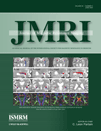Multiecho time-resolved acquisition (META): A high spatiotemporal resolution dixon imaging sequence for dynamic contrast-enhanced MRI
Abstract
Purpose
To evaluate a new dynamic contrast-enhanced (DCE) imaging technique called multiecho time-resolved acquisition (META) for abdominal/pelvic imaging. META combines an elliptical centric time-resolved three-dimensional (3D) spoiled gradient-recalled echo (SPGR) imaging scheme with a Dixon-based fat-water separation algorithm to generate high spatiotemporal resolution volumes.
Materials and Methods
Twenty-three patients referred for hepatic metastases or renal masses were imaged using the new META sequence and a conventional fat-suppressed 3D SPGR sequence on a 3T scanner. In 12 patients, equilibrium-phase 3D SPGR images acquired immediately after META were used for comparing the degree and homogeneity of fat suppression, artifacts, and overall image quality. In the remaining 11 of 23 patients, DCE 3D SPGR images acquired in a previous or subsequent examination were used for comparing the efficiency of arterial phase capture in addition to the qualitative analysis for the degree and homogeneity of fat suppression, artifacts, and overall image quality.
Results
META images were determined to be significantly better than conventional 3D SPGR images for degree and uniformity of fat suppression and ability to visualize the arterial phase. There were no significant differences in artifact levels or overall image quality.
Conclusion
META is a promising high spatiotemporal resolution imaging sequence for capturing the fast dynamics of hyperenhancing hepatic lesions and provides robust fat suppression even at 3T. J. Magn. Reson. Imaging 2009. © 2009 Wiley-Liss, Inc.




